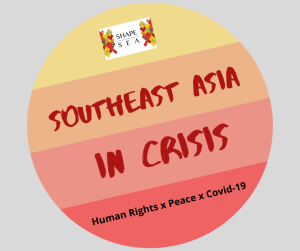Tania NguyenStudent, Asia Pacific MA Human Rights and DemocratisationGlobal Campus of Human Rights Asia PacificInstitute of Human Rights and Peace Studies, Mahidol University
 China’s rise in the South China Sea has been considered as one of the most critical security threats to ASEAN countries. It is assumed that the disputes over territory and sovereignty over ocean areas would have been suspended amid the outbreak of Coronavirus worldwide. However, that is not really what happened. China takes advantage of the COVID-19 crisis easing on the mainland and steps up the disputing on the South China Sea (Parameswaran, 2020). This action complicates the difficulty ASEAN states claimants already face in coping with the COVID-19 pandemic while the coping continues to create both internal and external security challenges.The South China Sea, a key commercial thoroughfare connecting Asia with Europe and Africa, is subject to variant overlapping territorial disputes involving China, Vietnam, Taiwan, the Philippines, Malaysia, and Brunei, based on various accounts of geography and history.China claims more than 80 percent of the South China Sea, including the archipelago of islands, reefs, and atolls known as the Spratlys. At the same time, Vietnam asserts sovereignty over the Paracel Islands and the Spratly Islands (SCMP Reporter, 2019). Also, Brunei and Malaysia have claimed sovereignty over southern parts of the sea and some of the Spratly Islands. The Philippines claims ownership of the Spratly Archipelago and the Scarborough Shoal. Over the decades, the claimants have seized control of a raft of sea features, including islands, rocks, and low-tide elevations. Since 2009, Beijing has advanced its territorial claims in this region through various tactics such as building artificial islands with military facilities over reefs and outcrops and using legal arguments and diplomatic influence. Its “nine-dash line,” which stretches as far as 2,000 kilometers from the mainland, is a geographical marker applied to strengthen its claim. The rival countries have wrangled over territory in the sea for centuries, but tension has steadily increased in recent years, especially during the pandemic.In early April, a Vietnamese fishing boat with eight crew members was sunk after being hit by a Chinese Coast Guard (CCG) ship near the disputed Paracels (Drake Long, 2020). The Vietnamese government has presumed China’s role in this incident, which may increase tension in the South China Sea. The incident also has prompted a stiff criticism from the United States that Beijing has exploited the pandemic to boost its unlawful claims in the South China Sea. Vietnam has claimed sovereignty over the Paracels but they have been occupied by China in their entirety since 1974.Since 15 April, Hai Yang Di Zhi 8 (a Chinese survey ship, with CCG and maritime military escort ships) has conducted its survey within Malaysia’s Exclusive Economic Zone (EEZ) (Drake Long). Consequently, a drillship contracted by Malaysian state-owned oil company Petronas called the West Capella that had been operating in Malaysian waters for five months left the region. The West Capella has finished its planned work and has left the area, Ian Cracknell, the company ™s communications director, said by e-mail. Nevertheless, Chinese activity has been widely acknowledged as an aggressive attempt to pressure Malaysia to stop oil exploration in overlapping waters, which both sides claim. The Malaysian government has yet to comment about the departure of the West Capella.The situation got worse when China perversely reiterated its annual fishing ban in the South China Sea on 1 May, outlawing all fishing activity in an area north of the 12th parallel of the sea that it claims to have jurisdiction over (Drake Long). The area is also claimed by Vietnam, Malaysia, the Philippines, and Taiwan. Fisheries associations from both Vietnam and the Philippines immediately protested China ™s ban. The ban is “invalid,” Vietnam said in a statement of defiance. It encouraged the nation ™s fishermen to continue with their fishing activities around the disputed Paracel Islands under the support of local authorities. The Malaysian government, however, has highlighted a differing approach in managing its maritime dispute with China. On 22 April, the Malaysian Foreign Minister said that he was consulting privately with both the United States and China, and urged all parties to refrain from sending more warships to the South China Sea (Drake Long). Similarly, Indonesia expressed its concern about recent activities in the region that would potentially lead to an escalation in tensions when a collective global effort is needed to combat the COVID-19 pandemic (Apriza Pinandita, 2020). Although Indonesia is not a claimant state, it has an EEZ in the Natuna islands on the edge of the South China Sea and has faced China ™s challenges to fish.Due to the tense situation, Vietnam and the Philippines have protested strongly against China ™s bullying, but other ASEAN states have been restrained (Nyshka Chandran, 2020). They have remarked on the importance of maintaining regional stability and avoiding conflict. The South China Sea Morning reported individual states would not act publicly against China for fear of affecting investment and trade ties, especially amid an economic downturn caused by the pandemic. China saw Southeast Asia as “its backyard.” For this reason, ASEAN has unobtrusively encouraged the United States and its allies to become more actively engaged in the region to balance China’s growing power. In practice, the United States and Australia have responded to China ™s recent activities by sending warships into the disputed South China Sea, maintaining regional stability to “promote freedom of navigation and overflight, and the international principles that underpin security and prosperity for the Indo-Pacific (Osborne, 2020). Whereas Washington and its allies’ presence is welcome, ASEAN countries not publicly admit it, nor would they attempt a collective response (Chandran 2020).Vietnam is in a critical strategic position in comparison with other ASEAN countries. In 2020, it is the ASEAN chair and a non-permanent member of the UN Security Council. Some suggested that Vietnam’s ASEAN roles should be extended into 2021 to make up for the time lost to dealing with the pandemic. If that happens, Hanoi should facilitate negotiations between ASEAN countries and China for a South China Sea code of conduct, which has been postponed as the pandemic rages on. Apart from defying China’s fishing ban and using legal arguments to ask China to comply with the UNCLOS, ASEAN countries should put aside their maritime disputes to build an ASEAN consensus — a new regional security architecture. It could be a Quad-plus arrangement, in which ASEAN countries work closely with the United States, Japan, India, Australia, and Taiwan to thwart future Chinese maritime expansion (Nguyen Quang Dy, 2020).In short, while not all of the ten ASEAN countries have territorial claims in the South China Sea, these countries as a bloc have been involved with China on managing and preventing conflict in one of the world’s busiest waterways that is rich in natural resources. Therefore, these states should reunite and work more closely with each other and their allies to thwart future Chinese maritime expansion. Peace, security, and stability in the region must be assured.References:Apriza Pinandita, 2020. Indonesia calls for parties to exercise self-restraint in the South China Sea amid pandemic. The Jarkata Post, 07 May. Available at: < https://www.thejakartapost.com/news/2020/05/07/indonesia-calls-for-parties-to-exercise-self-restraint-in-south-china-sea-amid-pandemic.html > .Drake Long, 2020. Vietnam Encourages Fishermen to Defy China South China Sea Ban. RFA, 12 May. Available at: <https://www.rfa.org/english/news/china/vietnam-southchinasea-05122020184639.html> .Nguyen Quang Dy, 2020. It is time for Vietnam and ASEAN to challenge Beijing in the South China Sea. The Strategist, 13 May. Available at: <https://www.aspistrategist.org.au/its-time-for-vietnam-and-asean-to-challenge-beijing-in-the-south-china-sea/> .Nyshka Chandran, 2020. ASEAN stays on the sidelines as South China Sea tensions mount. South China Morning Post, 16 May. Available at: <https://www.scmp.com/week-asia/politics/article/3084647/asean-stays-sidelines-south-china-sea-tensions-mount> .Prashanth Parameswaran, 2020. The South China Sea and the Coronavirus: New Vietnam-China Incident Spotlights Old Realities. The Diplomat, 06 April. Available at: <https://thediplomat.com/2020/04/south-china-sea-and-the-coronavirus-new-vietnam-china-incident-spotlights-old-realities/ > .SCMP Reporter, 2019. Explainer | Explained: South China Sea dispute. South China Morning Post, 16 February. Available at: <https://www.scmp.com/week-asia/article/2186449/explained-south-china-sea-dispute> .Simon Osborne, 2020. Watch out, China: the US and Australia send warships into disputed South China Sea. Express, 22 April. Available at:<https://www.express.co.uk/news/world/1272327/south-china-sea-warships-us-navy-australian-navy-china-oil-exploration> .
China’s rise in the South China Sea has been considered as one of the most critical security threats to ASEAN countries. It is assumed that the disputes over territory and sovereignty over ocean areas would have been suspended amid the outbreak of Coronavirus worldwide. However, that is not really what happened. China takes advantage of the COVID-19 crisis easing on the mainland and steps up the disputing on the South China Sea (Parameswaran, 2020). This action complicates the difficulty ASEAN states claimants already face in coping with the COVID-19 pandemic while the coping continues to create both internal and external security challenges.The South China Sea, a key commercial thoroughfare connecting Asia with Europe and Africa, is subject to variant overlapping territorial disputes involving China, Vietnam, Taiwan, the Philippines, Malaysia, and Brunei, based on various accounts of geography and history.China claims more than 80 percent of the South China Sea, including the archipelago of islands, reefs, and atolls known as the Spratlys. At the same time, Vietnam asserts sovereignty over the Paracel Islands and the Spratly Islands (SCMP Reporter, 2019). Also, Brunei and Malaysia have claimed sovereignty over southern parts of the sea and some of the Spratly Islands. The Philippines claims ownership of the Spratly Archipelago and the Scarborough Shoal. Over the decades, the claimants have seized control of a raft of sea features, including islands, rocks, and low-tide elevations. Since 2009, Beijing has advanced its territorial claims in this region through various tactics such as building artificial islands with military facilities over reefs and outcrops and using legal arguments and diplomatic influence. Its “nine-dash line,” which stretches as far as 2,000 kilometers from the mainland, is a geographical marker applied to strengthen its claim. The rival countries have wrangled over territory in the sea for centuries, but tension has steadily increased in recent years, especially during the pandemic.In early April, a Vietnamese fishing boat with eight crew members was sunk after being hit by a Chinese Coast Guard (CCG) ship near the disputed Paracels (Drake Long, 2020). The Vietnamese government has presumed China’s role in this incident, which may increase tension in the South China Sea. The incident also has prompted a stiff criticism from the United States that Beijing has exploited the pandemic to boost its unlawful claims in the South China Sea. Vietnam has claimed sovereignty over the Paracels but they have been occupied by China in their entirety since 1974.Since 15 April, Hai Yang Di Zhi 8 (a Chinese survey ship, with CCG and maritime military escort ships) has conducted its survey within Malaysia’s Exclusive Economic Zone (EEZ) (Drake Long). Consequently, a drillship contracted by Malaysian state-owned oil company Petronas called the West Capella that had been operating in Malaysian waters for five months left the region. The West Capella has finished its planned work and has left the area, Ian Cracknell, the company ™s communications director, said by e-mail. Nevertheless, Chinese activity has been widely acknowledged as an aggressive attempt to pressure Malaysia to stop oil exploration in overlapping waters, which both sides claim. The Malaysian government has yet to comment about the departure of the West Capella.The situation got worse when China perversely reiterated its annual fishing ban in the South China Sea on 1 May, outlawing all fishing activity in an area north of the 12th parallel of the sea that it claims to have jurisdiction over (Drake Long). The area is also claimed by Vietnam, Malaysia, the Philippines, and Taiwan. Fisheries associations from both Vietnam and the Philippines immediately protested China ™s ban. The ban is “invalid,” Vietnam said in a statement of defiance. It encouraged the nation ™s fishermen to continue with their fishing activities around the disputed Paracel Islands under the support of local authorities. The Malaysian government, however, has highlighted a differing approach in managing its maritime dispute with China. On 22 April, the Malaysian Foreign Minister said that he was consulting privately with both the United States and China, and urged all parties to refrain from sending more warships to the South China Sea (Drake Long). Similarly, Indonesia expressed its concern about recent activities in the region that would potentially lead to an escalation in tensions when a collective global effort is needed to combat the COVID-19 pandemic (Apriza Pinandita, 2020). Although Indonesia is not a claimant state, it has an EEZ in the Natuna islands on the edge of the South China Sea and has faced China ™s challenges to fish.Due to the tense situation, Vietnam and the Philippines have protested strongly against China ™s bullying, but other ASEAN states have been restrained (Nyshka Chandran, 2020). They have remarked on the importance of maintaining regional stability and avoiding conflict. The South China Sea Morning reported individual states would not act publicly against China for fear of affecting investment and trade ties, especially amid an economic downturn caused by the pandemic. China saw Southeast Asia as “its backyard.” For this reason, ASEAN has unobtrusively encouraged the United States and its allies to become more actively engaged in the region to balance China’s growing power. In practice, the United States and Australia have responded to China ™s recent activities by sending warships into the disputed South China Sea, maintaining regional stability to “promote freedom of navigation and overflight, and the international principles that underpin security and prosperity for the Indo-Pacific (Osborne, 2020). Whereas Washington and its allies’ presence is welcome, ASEAN countries not publicly admit it, nor would they attempt a collective response (Chandran 2020).Vietnam is in a critical strategic position in comparison with other ASEAN countries. In 2020, it is the ASEAN chair and a non-permanent member of the UN Security Council. Some suggested that Vietnam’s ASEAN roles should be extended into 2021 to make up for the time lost to dealing with the pandemic. If that happens, Hanoi should facilitate negotiations between ASEAN countries and China for a South China Sea code of conduct, which has been postponed as the pandemic rages on. Apart from defying China’s fishing ban and using legal arguments to ask China to comply with the UNCLOS, ASEAN countries should put aside their maritime disputes to build an ASEAN consensus — a new regional security architecture. It could be a Quad-plus arrangement, in which ASEAN countries work closely with the United States, Japan, India, Australia, and Taiwan to thwart future Chinese maritime expansion (Nguyen Quang Dy, 2020).In short, while not all of the ten ASEAN countries have territorial claims in the South China Sea, these countries as a bloc have been involved with China on managing and preventing conflict in one of the world’s busiest waterways that is rich in natural resources. Therefore, these states should reunite and work more closely with each other and their allies to thwart future Chinese maritime expansion. Peace, security, and stability in the region must be assured.References:Apriza Pinandita, 2020. Indonesia calls for parties to exercise self-restraint in the South China Sea amid pandemic. The Jarkata Post, 07 May. Available at: < https://www.thejakartapost.com/news/2020/05/07/indonesia-calls-for-parties-to-exercise-self-restraint-in-south-china-sea-amid-pandemic.html > .Drake Long, 2020. Vietnam Encourages Fishermen to Defy China South China Sea Ban. RFA, 12 May. Available at: <https://www.rfa.org/english/news/china/vietnam-southchinasea-05122020184639.html> .Nguyen Quang Dy, 2020. It is time for Vietnam and ASEAN to challenge Beijing in the South China Sea. The Strategist, 13 May. Available at: <https://www.aspistrategist.org.au/its-time-for-vietnam-and-asean-to-challenge-beijing-in-the-south-china-sea/> .Nyshka Chandran, 2020. ASEAN stays on the sidelines as South China Sea tensions mount. South China Morning Post, 16 May. Available at: <https://www.scmp.com/week-asia/politics/article/3084647/asean-stays-sidelines-south-china-sea-tensions-mount> .Prashanth Parameswaran, 2020. The South China Sea and the Coronavirus: New Vietnam-China Incident Spotlights Old Realities. The Diplomat, 06 April. Available at: <https://thediplomat.com/2020/04/south-china-sea-and-the-coronavirus-new-vietnam-china-incident-spotlights-old-realities/ > .SCMP Reporter, 2019. Explainer | Explained: South China Sea dispute. South China Morning Post, 16 February. Available at: <https://www.scmp.com/week-asia/article/2186449/explained-south-china-sea-dispute> .Simon Osborne, 2020. Watch out, China: the US and Australia send warships into disputed South China Sea. Express, 22 April. Available at:<https://www.express.co.uk/news/world/1272327/south-china-sea-warships-us-navy-australian-navy-china-oil-exploration> .





